vis–NIR and XRF Data Fusion and Feature Selection to Estimate Potentially Toxic Elements in Soil
Abstract
1. Introduction
2. Materials and Methods
2.1. Study Area, Soil Sampling, and Soil Analysis
2.2. Spectral Data Acquisition and Pre-Processing
2.2.1. vis–NIR Spectroscopy
2.2.2. XRF Spectroscopy
2.3. Feature Selection
2.4. Data Fusion
2.5. Model Construction and Evaluation
3. Results
3.1. Descriptive Statistics, Spectral Response, and Correlation of PTEs, Total Fe, and SOC
3.2. Estimation of PTEs Using the Single Spectrometers Full-Range Spectra
3.3. Estimation of PTEs Using the Single Spectrometers Feature-Selected Spectra
3.4. Estimation of PTEs Using vis–NIR and XRF Data Fusion
3.5. Comparison of Models Derived from Different Spectral Data Sets
4. Discussion
5. Conclusions
Author Contributions
Funding
Data Availability Statement
Acknowledgments
Conflicts of Interest
References
- Shi, T.; Chen, Y.; Liu, Y.; Wu, G. Visible and near-infrared reflectance spectroscopy—An alternative for monitoring soil contamination by heavy metals. J. Hazard. Mater. 2014, 265, 166–176. [Google Scholar] [CrossRef] [PubMed]
- Khosravi, V.; Ardejani, F.D.; Yousefi, S.; Aryafar, A. Monitoring soil lead and zinc contents via combination of spectroscopy with extreme learning machine and other data mining methods. Geoderma 2018, 318, 29–41. [Google Scholar] [CrossRef]
- Bruemmer, G.W.; Gerth, J.; Herms, U. Heavy metal species, mobility and availability in soils. Z. für Pflanzenernährung und Bodenkd. 1986, 149, 382–398. [Google Scholar] [CrossRef]
- García-Sánchez, F.; Galvez-Sola, L.; Martínez-Nicolás, J.J.; Muelas-Domingo, R.; Nieves, M. Developments in Near-Infrared Spectroscopy; IntechOpen: London, UK, 2017; pp. 97–127. [Google Scholar] [CrossRef]
- Gholizadeh, A.; Saberioon, M.; Ben-Dor, E.; Borůvka, L. Monitoring of selected soil contaminants using proximal and remote sensing techniques: Background, state-of-the-art and future perspectives. Crit. Rev. Environ. Sci. Technol. 2018, 48, 1–36. [Google Scholar] [CrossRef]
- Gholizadeh, A.; Borůvka, L.; Vašát, R.; Saberioon, M.; Klement, A.; Kratina, J.; Tejnecký, V.; Drábek, O. Estimation of potentially toxic elements contamination in anthropogenic soils on a brown coal mining dumpsite by reflectance spectroscopy: A case study. PLoS ONE 2015, 10, e0117457. [Google Scholar] [CrossRef] [PubMed]
- Shi, T.; Guo, L.; Chen, Y.; Wang, W.; Shi, Z.; Li, Q.; Wu, G. Proximal and remote sensing techniques for mapping of soil contamination with heavy metals. Appl. Spectrosc. Rev. 2018, 53, 1–23. [Google Scholar] [CrossRef]
- Viscarra Rossel, R.; Walter, C. Rapid, quantitative and spatial field measurements of soil pH using an ion sensitive field effect transistor. Geoderma 2004, 119, 9–20. [Google Scholar] [CrossRef]
- Sacristán, D.; Rossel, R.A.V.; Recatalá, L. Proximal sensing of Cu in soil and lettuce using portable X-ray fluorescence spectrometry. Geoderma 2016, 265, 6–11. [Google Scholar] [CrossRef]
- Viscarra Rossel, R.; Adamchuk, V.; Sudduth, K.; McKenzie, N.; Lobsey, C. Chapter five proximal soil sensing: An effective approach for soil measurements in space and time. Adv. Agron. 2011, 113, 243–291. [Google Scholar] [CrossRef]
- Stenberg, B.; Rossel, R.A.V.; Mouazen, A.M.; Wetterlind, J. Chapter five visible and near infrared spectroscopy in soil science. Adv. Agron. 2010, 107, 163–215. [Google Scholar] [CrossRef]
- Gholizadeh, A.; Saberioon, M.; Ben-Dor, E.; Rossel, R.A.V.; Boruvka, L. Modelling potentially toxic elements in forest soils with vis–NIR spectra and learning algorithms. Environ. Pollut. 2020, 267, 115574. [Google Scholar] [CrossRef]
- Pozza, L.E.; Bishop, T.F.A.; Stockmann, U.; Birch, G.F. Integration of vis-NIR and pXRF spectroscopy for rapid measurement of soil lead concentrations. Soil Res. 2020, 58, 247. [Google Scholar] [CrossRef]
- Wu, Y.; Chen, J.; Wu, X.; Tian, Q.; Ji, J.; Qin, Z. Possibilities of reflectance spectroscopy for the assessment of contaminant elements in suburban soils. Appl. Geochem. 2005, 20, 1051–1059. [Google Scholar] [CrossRef]
- Liu, M.; Wang, T.; Skidmore, A.K.; Liu, X. Heavy metal-induced stress in rice crops detected using multi-temporal Sentinel-2 satellite images. Sci. Total Environ. 2018, 637, 18–29. [Google Scholar] [CrossRef] [PubMed]
- Adler, K.; Piikki, K.; Söderström, M.; Eriksson, J.; Alshihabi, O. Predictions of Cu, Zn, and Cd concentrations in soil using portable X-ray fluorescence measurements. Sensors 2020, 20, 474. [Google Scholar] [CrossRef] [PubMed]
- Wang, S.Q.; Li, W.D.; Li, J.; Liu, X.S. Prediction of Soil Texture Using FT-NIR Spectroscopy and PXRF Spectrometry with Data Fusion. Soil Sci. 2013, 178, 626–638. [Google Scholar] [CrossRef]
- Molin, J.A.P.; Tavares, T.R. Sensor system for mapping soil fertility attributes: Challenges, Advances, and perspectives in Brazilian tropical soils. Eng. AgrÃcola 2019, 39, 126–147. [Google Scholar] [CrossRef]
- Wan, M.; Qu, M.; Hu, W.; Li, W.; Zhang, C.; Cheng, H.; Huang, B. Estimation of soil pH using PXRF spectrometry and Vis-NIR spectroscopy for rapid environmental risk assessment of soil heavy metals. Process. Saf. Environ. Prot. 2019, 132, 73–81. [Google Scholar] [CrossRef]
- Xu, D.; Zhao, R.; Li, S.; Chen, S.; Jiang, Q.; Zhou, L.; Shi, Z. Multi-sensor fusion for the determination of several soil properties in the Yangtze River Delta, China. Eur. J. Soil Sci. 2019, 70, 162–173. [Google Scholar] [CrossRef]
- Zhang, Y.; Hartemink, A.E. Data fusion of vis–NIR and PXRF spectra to predict soil physical and chemical properties. Eur. J. Soil Sci. 2019, 71, 316–333. [Google Scholar] [CrossRef]
- Aldabaa, A.A.A.; Weindorf, D.C.; Chakraborty, S.; Sharma, A.; Li, B. Combination of proximal and remote sensing methods for rapid soil salinity quantification. Geoderma 2015, 239, 34–46. [Google Scholar] [CrossRef]
- Chakraborty, S.; Weindorf, D.C.; Li, B.; Aldabaa, A.A.A.; Ghosh, R.K.; Paul, S.; Ali, M.N. Development of a hybrid proximal sensing method for rapid identification of petroleum contaminated soils. Sci. Total Environ. 2015, 514, 399–408. [Google Scholar] [CrossRef]
- Xu, D.; Chen, S.; Xu, H.; Wang, N.; Zhou, Y.; Shi, Z. Data fusion for the measurement of potentially toxic elements in soil using portable spectrometers. Environ. Pollut. 2020, 263, 114649. [Google Scholar] [CrossRef] [PubMed]
- Ji, W.; Adamchuk, V.I.; Chen, S.; Su, A.S.M.; Ismail, A.; Gan, Q.; Shi, Z.; Biswas, A. Simultaneous measurement of multiple soil properties through proximal sensor data fusion: A case study. Geoderma 2019, 341, 111–128. [Google Scholar] [CrossRef]
- Xu, D.; Chen, S.; Rossel, R.V.; Biswas, A.; Li, S.; Zhou, Y.; Shi, Z. X-ray fluorescence and visible near infrared sensor fusion for predicting soil chromium content. Geoderma 2019, 352, 61–69. [Google Scholar] [CrossRef]
- O’Rourke, S.; Minasny, B.; Holden, N.; McBratney, A. Synergistic use of Vis-NIR, MIR, and XRF spectroscopy for the determination of soil geochemistry. Soil Sci. Soc. Am. J. 2016, 80, 888–899. [Google Scholar] [CrossRef]
- Mouazen, A.; Kuang, B.; Baerdemaeker, J.D.; Ramon, H. Comparison among principal component, partial least squares and back propagation neural network analyses for accuracy of measurement of selected soil properties with visible and near infrared spectroscopy. Geoderma 2010, 158, 23–31. [Google Scholar] [CrossRef]
- Nawar, S.; Buddenbaum, H.; Hill, J.; Kozak, J.; Mouazen, A.M. Estimating the soil clay content and organic matter by means of different calibration methods of vis-NIR diffuse reflectance spectroscopy. Soil Tillage Res. 2016, 155, 510–522. [Google Scholar] [CrossRef]
- Borůvka, L.; Vácha, R. Litavka river alluvium as a model area heavily polluted with potentially risk elements. In Phytoremediation of Metal-Contaminated Soils; Morel, J.L., Echevarria, G., Goncharova, N., Eds.; Springer: Dordrecht, The Netherlands, 2006; pp. 267–298. [Google Scholar]
- Famera, M.; Kotkova, K.; Tumova, S.; Elznicova, J.; Matys Grygar, T. Pollution distribution in floodplain structure visualised by electrical resistivity imaging in the floodplain of the Litavka River, the Czech Republic. Catena 2018, 165, 157–172. [Google Scholar] [CrossRef]
- IUSS Working Group WRB. World Reference Base for Soil Resources 2014, Update 2015: International Soil Classification System for Naming Soils and Creating Legends for Soil Maps; Technical Report; FAO: Rome, Italy, 2015. [Google Scholar]
- Sparks, D. Methods of Soil Analysis. Part 3–Chemical Methods; Soil Science Society of America, American Society of Agronomy: Madison, WI, USA, 1996. [Google Scholar]
- Ben-Dor, E.; Banin, A. Near-infrared analysis as a rapid method to simultaneously evaluate several soil properties. Soil Sci. Soc. Am. J. 1995, 59, 364–372. [Google Scholar] [CrossRef]
- Fujii, K.; Ikeda, S.; Akama, A.; Komatsu, M.; Takahashi, M.; Kaneko, S. Vertical migration of radiocesium and clay mineral composition in five forest soils contaminated by the Fukushima nuclear accident. Soil Sci. Plant Nutr. 2014, 60, 751–764. [Google Scholar] [CrossRef]
- Hewavitharana, A.K. Matrix matching in liquid chromatography-mass spectrometry with stable isotope labelled internal standards–is it necessary? J. Chromatogr. 2011, 1218, 359–361. [Google Scholar] [CrossRef]
- Ben-Dor, E.; Ong, C.; Lau, I.C. Reflectance measurements of soils in the laboratory: Standards and protocols. Geoderma 2015, 245, 112–124. [Google Scholar] [CrossRef]
- Savitzky, A.; Golay, M.J.E. Smoothing and differentiation of data by simplified least squares procedures. Anal. Chem. 1964, 36, 1627–1639. [Google Scholar] [CrossRef]
- Gholizadeh, A.; Žižala, D.; Saberioon, M.; Borůvka, L. Soil organic carbon and texture retrieving and mapping using proximal, airborne and Sentinel-2 spectral imaging. Remote Sens. Environ. 2018, 218, 89–103. [Google Scholar] [CrossRef]
- Gholizadeh, A.; Borůvka, L.; Saberioon, M.; Vašát, R. Visible, near-Infrared, and mid-infrared spectroscopy applications for soil assessment with emphasis on soil organic matter content and quality: State-of-the-art and key issues. Appl. Spectrosc. 2013, 67, 1349–1362. [Google Scholar] [CrossRef]
- Aggarwal, C.C. Outlier ensembles: Position paper. ACM SIGKDD Explor. Newsl. 2013, 14, 49–58. [Google Scholar] [CrossRef]
- Kebonye, N.M.; John, K.; Chakraborty, S.; Agyeman, P.C.; Ahado, S.K.; Eze, P.N.; Němeček, K.; Drábek, O.; Borůvka, L. Comparison of multivariate methods for arsenic estimation and mapping in floodplain soil via portable X-ray fluorescence spectroscopy. Geoderma 2021, 384, 114792. [Google Scholar] [CrossRef]
- Xiaobo, Z.; Jiewen, Z.; Povey, M.J.; Holmes, M.; Hanpin, M. Variables selection methods in near-infrared spectroscopy. Anal. Chim. Acta 2010, 667, 14–32. [Google Scholar] [CrossRef]
- Solorio-Fernández, S.; Carrasco-Ochoa, J.A.; Martínez-Trinidad, J.F. A review of unsupervised feature selection methods. Artif. Intell. Rev. 2020, 53, 907–948. [Google Scholar] [CrossRef]
- Reda, R.; Saffaj, T.; Ilham, B.; Saidi, O.; Issam, K.; Brahim, L.; Hadrami, E.E. A comparative study between a new method and other machine learning algorithms for soil organic carbon and total nitrogen prediction using near infrared spectroscopy. Chemom. Intell. Lab. Syst. 2019, 195, 103873. [Google Scholar] [CrossRef]
- Padungweang, P.; Lursinsap, C.; Sunat, K. Univariate filter technique for unsupervised feature selection using a new Laplacian score based local nearest neighbors. In Proceedings of the 2009 IEEEAsia-Pacific Conference on Information Processing, Shenzhen, China, 18–19 July 2009; Volume 2, pp. 196–200. [Google Scholar] [CrossRef]
- Vohland, M.; Besold, J.; Hill, J.; Fründ, H.C. Comparing different multivariate calibration methods for the determination of soil organic carbon pools with visible to near infrared spectroscopy. Geoderma 2011, 166, 198–205. [Google Scholar] [CrossRef]
- Leardi, R.; González, A.L. Genetic algorithms applied to feature selection in PLS regression: How and when to use them. Chemom. Intell. Lab. Syst. 1998, 41, 195–207. [Google Scholar] [CrossRef]
- Yoshida, H.; Leardi, R.; Funatsu, K.; Varmuza, K. Feature selection by genetic algorithms for mass spectral classifiers. Anal. Chim. Acta 2001, 446, 483–492. [Google Scholar] [CrossRef]
- Murthy, C.A.; Chowdhury, N. In search of optimal clusters using genetic algorithms. Pattern Recognit. Lett. 1996, 17, 825–832. [Google Scholar] [CrossRef]
- Kuhn, M. Building predictive models in R using the caret package. J. Stat. Softw. Artic. 2008, 28, 1–26. [Google Scholar] [CrossRef]
- Viscarra Rossel, R.; Walvoort, D.; McBratney, A.; Janik, L.; Skjemstad, J. Visible, near infrared, mid infrared or combined diffuse reflectance spectroscopy for simultaneous assessment of various soil properties. Geoderma 2006, 131, 59–75. [Google Scholar] [CrossRef]
- Wan, M.; Hu, W.; Qu, M.; Li, W.; Zhang, C.; Kang, J.; Hong, Y.; Chen, Y.; Huang, B. Rapid estimation of soil cation exchange capacity through sensor data fusion of portable XRF spectrometry and Vis-NIR spectroscopy. Geoderma 2020, 363, 114163. [Google Scholar] [CrossRef]
- Kooistra, L.; Wanders, J.; Epema, G.; Leuven, R.; Wehrens, R.; Buydens, L. The potential of field spectroscopy for the assessment of sediment properties in river floodplains. Anal. Chim. Acta 2003, 484, 189–200. [Google Scholar] [CrossRef]
- Gholizadeh, A.; Boruvka, L.; Saberioon, M.; Vasat, R. A memory-based learning approach as compared to other data mining algorithms for the prediction of soil texture using diffuse reflectance Spectra. Remote Sens. 2016, 8, 341. [Google Scholar] [CrossRef]
- Gholizadeh, A.; Saberioon, M.; Carmon, N.; Boruvka, L.; Ben-Dor, E. Examining the performance of PARACUDA-II data-mining engine versus selected techniques to model soil carbon from reflectance spectra. Remote Sens. 2018, 10, 1172. [Google Scholar] [CrossRef]
- Hastie, T.; Tibshirani, R.; Friedman, J. The Elements of Statistical Learning: Data Mining, Inference, and Prediction; Springer Science & Business Media: Berlin/Heidelberg, Germany, 2009. [Google Scholar]
- Bellon-Maurel, V.; Fernandez-Ahumada, E.; Palagos, B.; Roger, J.M.; McBratney, A. Critical review of chemometric indicators commonly used for assessing the quality of the prediction of soil attributes by NIR spectroscopy. TrAC Trends Anal. Chem. 2010, 29, 1073–1081. [Google Scholar] [CrossRef]
- Gomez, C.; Gholizadeh, A.; Borůvka, L.; Lagacherie, P. Using legacy data for correction of soil surface clay content predicted from VNIR/SWIR hyperspectral airborne images. Geoderma 2016, 276, 84–92. [Google Scholar] [CrossRef]
- Suchara, I.; Sucharová, J. Distribution of sulphur and heavy metals in forest floor humus of the Czech Republic. Water Air Soil Pollut. 2002, 136, 289–316. [Google Scholar] [CrossRef]
- Sucharová, J.; Suchara, I.; Hola, M.; Reimann, C.; Boyd, R.; Filzmoser, P.; Englmaier, P. Linking chemical elements in forest floor humus (Oh-horizon) in the Czech Republic to contamination sources. Environ. Pollut. 2011, 159, 1205–1214. [Google Scholar] [CrossRef]
- Borůvka, L.; Sramek, V.; Cupr, P.; Fadrhonsova, V.; Hofman, J.; Houska, J.; Sanka, O.; Slavikova, A.A.; Sindelarova, L.; Tejnecky, V.; et al. Srovnávací Hodnoty pro Hodnocení Kontaminace Lesních pud: Certifikovaná Metodika; Výzkumný ústav Lesního Hospodářství a Myslivosti: Strnady, Czech Republic, 2015. [Google Scholar]
- Pavlů, L.; Drábek, O.; Borůvka, L.; Nikodem, A.; Němeček, K. Degradation of forest soils in the vicinity of an industrial zone. Soil Water Res. 2016, 10, 65–73. [Google Scholar] [CrossRef]
- Wilding, L. Spatial variability: Its documentation, accommodation and implication to soil surveys. In Proceedings of the Soil Spatial Variability, Las Vegas, NV, USA, 30 November–1 December 1984; pp. 166–194. [Google Scholar]
- Xu, S.; Zhao, Y.; Wang, M.; Shi, X. Comparison of multivariate methods for estimating selected soil properties from intact soil cores of paddy fields by Vis–NIR spectroscopy. Geoderma 2018, 310, 29–43. [Google Scholar] [CrossRef]
- Hu, B.; Chen, S.; Hu, J.; Xia, F.; Xu, J.; Li, Y.; Shi, Z. Application of portable XRF and VNIR sensors for rapid assessment of soil heavy metal pollution. PLoS ONE 2017, 12, 1–13. [Google Scholar] [CrossRef]
- Chang, C.W.; Laird, D.A.; Mausbach, M.J.; Hurburgh, C.R. Near-infrared reflectance spectroscopy–principal components regression analyses of soil properties. Soil Sci. Soc. Am. J. 2001, 65, 480–490. [Google Scholar] [CrossRef]
- Jia, J.; Song, Y.; Yuan, X.; Yang, Z. Diffuse reflectance spectroscopy study of heavy metals in agricultural soils of the Changjiang river delta, China. In Proceedings of the 19th World Congress of Soil Science, Brisbane, Australia, 1–6 August 2010. [Google Scholar]
- Wu, Y.; Chen, J.; Ji, J.; Gong, P.; Liao, Q.; Tian, Q.; Ma, H. A Mechanism Study of Reflectance Spectroscopy for Investigating Heavy Metals in Soils. Soil Sci. Soc. Am. J. 2007, 71, 918–926. [Google Scholar] [CrossRef]
- Heller Pearlshtien, D.; Ben-Dor, E. Effect of Organic Matter Content on the Spectral Signature of Iron Oxides across the VIS–NIR Spectral Region in Artificial Mixtures: An Example from a Red Soil from Israel. Remote Sens. 2020, 12, 1960. [Google Scholar] [CrossRef]
- Hong, Y.; Shen, R.; Cheng, H.; Chen, Y.; Zhang, Y.; Liu, Y.; Zhou, M.; Yu, L.; Liu, Y.; Liu, Y. Estimating lead and zinc concentrations in peri-urban agricultural soils through reflectance spectroscopy: Effects of fractional-order derivative and random forest. Sci. Total Environ. 2018, 651, 1969–1982. [Google Scholar] [CrossRef]
- Richter, N.; Jarmer, T.; Chabrillat, S.; Oyonarte, C.; Hostert, P.; Kaufmann, H. Free iron oxide determination in Mediterranean soils using diffuse reflectance spectroscopy. Soil Sci. Soc. Am. J. 2009, 73, 72–81. [Google Scholar] [CrossRef]
- Simon, M.; Martin, F.; Ortiz, I.; Garcia, I.; Fernandez, J.; Fernandez, E.; Dorronsoro, C.; Aguilar, J. Soil pollution by oxidation of tailings from toxic spill of a pyrite mine. Sci. Total Environ. 2001, 279, 63–74. [Google Scholar] [CrossRef]
- Horta, A.; Malone, B.; Stockmann, U.; Minasny, B.; Bishop, T.; McBratney, A.; Pallasser, R.; Pozza, L. Potential of integrated field spectroscopy and spatial analysis for enhanced assessment of soil contamination: A prospective review. Geoderma 2015, 241–242, 180–209. [Google Scholar] [CrossRef]
- Estienne, F.; Massart, D.; Zanier-Szydlowski, N.; Marteau, P. Multivariate calibration with Raman spectroscopic data: A case study. Anal. Chim. Acta 2000, 424, 185–201. [Google Scholar] [CrossRef]
- Vohland, M.; Emmerling, C. Determination of total soil organic C and hot water-extractable C from VIS-NIR soil reflectance with partial least squares regression and spectral feature selection techniques. Eur. J. Soil Sci. 2011, 62, 598–606. [Google Scholar] [CrossRef]
- Vohland, M.; Michel, K.; Ludwig, B. Use of near-infrared spectroscopy to distinguish carbon and nitrogen originating from char and forest-floor material in soils: Usefulness of a genetic algorithm. J. Plant Nutr. Soil Sci. 2011, 174, 695–701. [Google Scholar] [CrossRef]
- Laiho, J.; Peramaki, P. Evaluation of portable X-ray fluorescence (PXRF) sample preparation methods. Spec. Pap.-Geol. Surv. Finl. 2005, 38, 73. [Google Scholar]
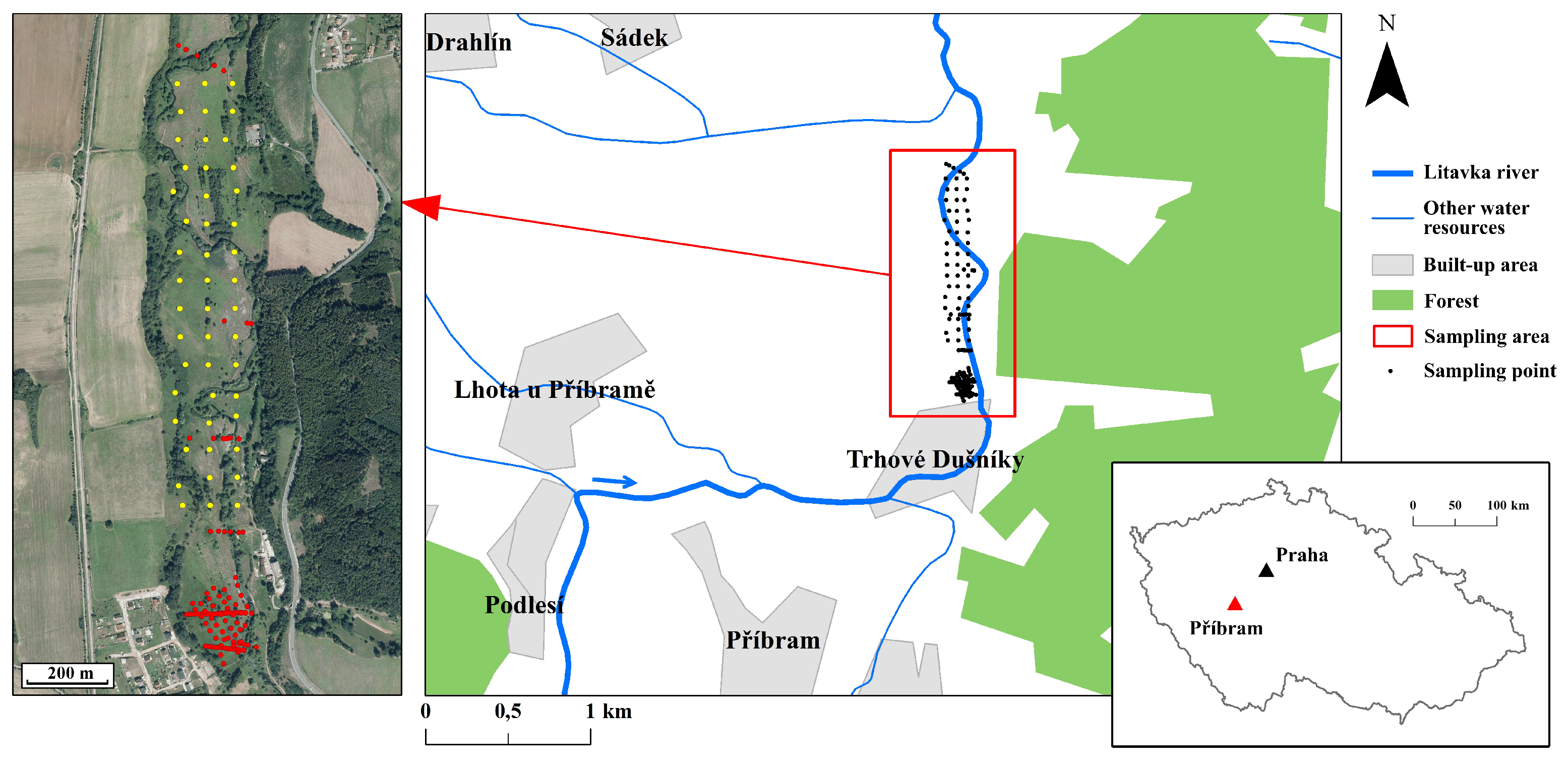

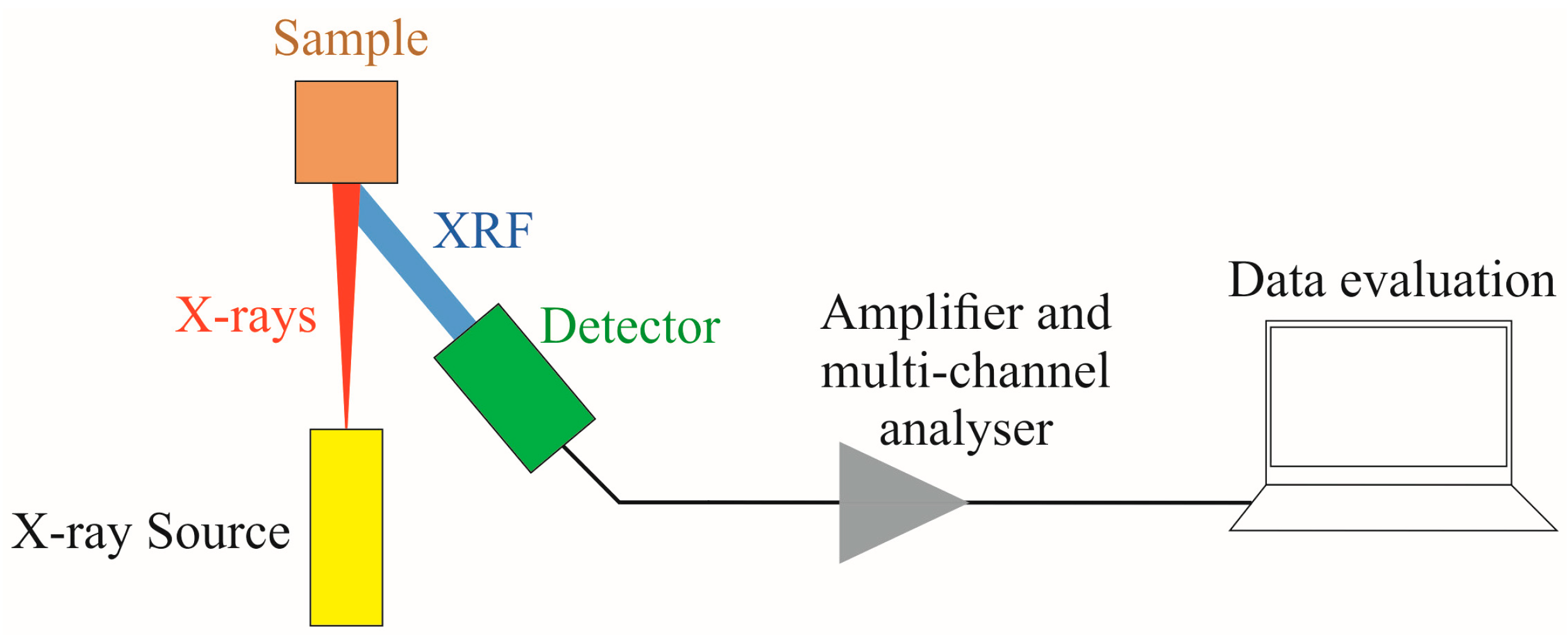
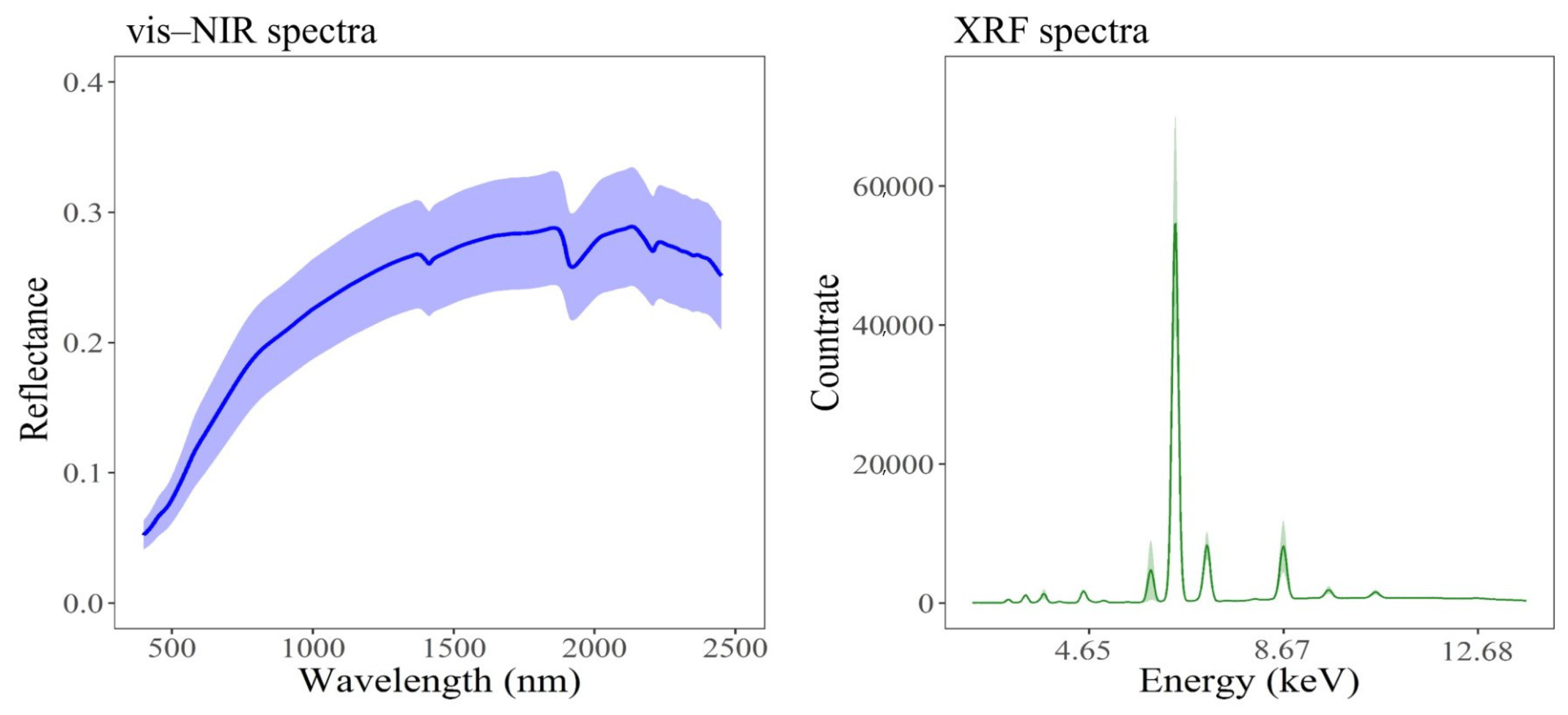
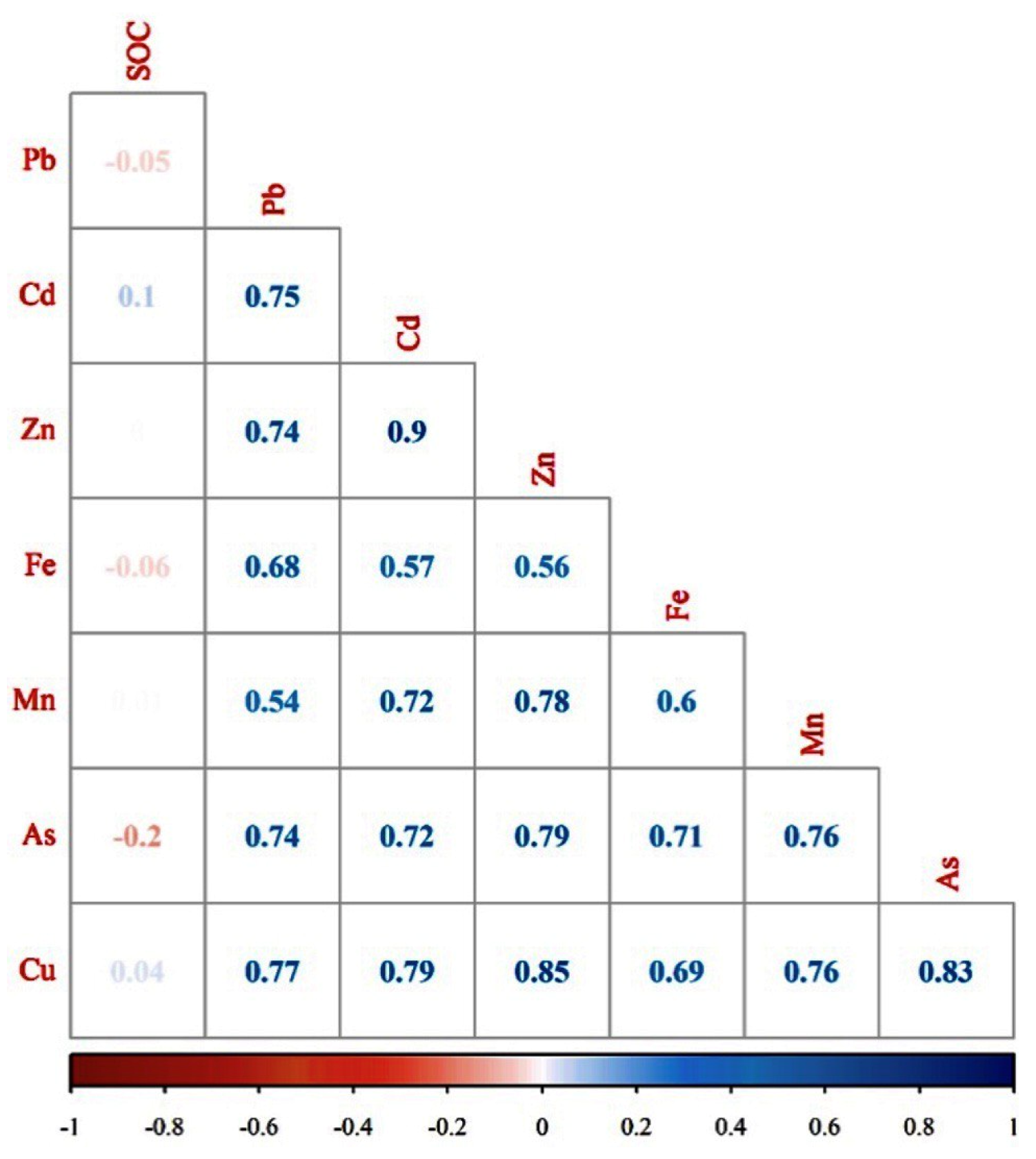
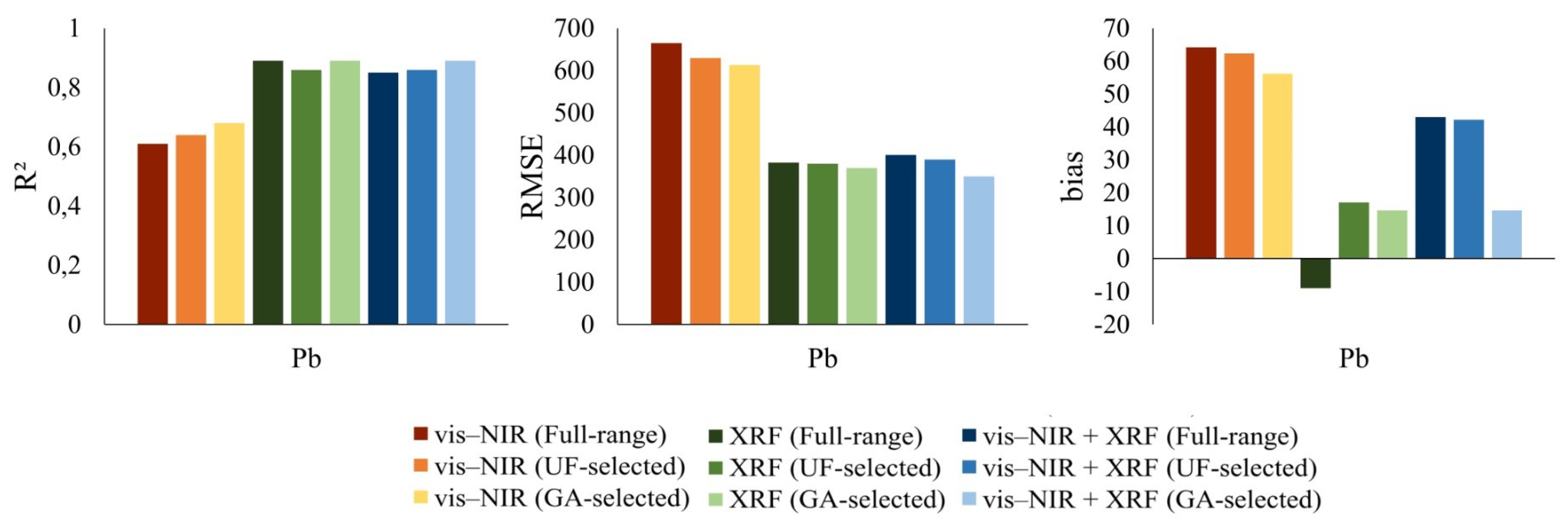

| Element | No. | Unit | Mean | Median | Min | Max | SD | CV% | Skewness |
|---|---|---|---|---|---|---|---|---|---|
| As | 150 | 200 | 197 | 4.50 | 492 | 102 | 51 | 0.3 | |
| Cd | 152 | 24.2 | 24.5 | 1.60 | 48.4 | 10.3 | 43 | 0.0 | |
| Cu | 151 | 54.6 | 53.7 | 13.2 | 104 | 19.6 | 35 | 0.3 | |
| Pb | 152 | (mg/kg) | 1803 | 1656 | 37.9 | 4170 | 920 | 51 | 0.5 |
| Zn | 154 | 2217 | 2124 | 49.4 | 5351 | 1128 | 51 | 0.4 | |
| Mn | 142 | 2380 | 2324 | 499 | 5720 | 1140 | 48 | 0.8 | |
| Fe | 152 | 20,973 | 20,503 | 9670 | 35,428 | 5522 | 26 | 0.4 | |
| SOC | 147 | (%) | 3.1 | 2.9 | 0.9 | 6.2 | 1.1 | 35 | 0.5 |
| Element | Sensor | Data Set | R | RMSE | Bias |
|---|---|---|---|---|---|
| As | vis–NIR | Full-range | 0.59 | 76.7 | 11.9 |
| UF-selected | 0.55 | 78.5 | 13.8 | ||
| GA-selected | 0.61 | 76.5 | 9.43 | ||
| XRF | Full-range | 0.77 | 58.2 | 14.4 | |
| UF-selected | 0.70 | 66.4 | 15.8 | ||
| GA-selected | 0.82 | 52.5 | 14.4 | ||
| Cd | vis–NIR | Full-range | 0.25 | 8.42 | −1.90 |
| UF-selected | 0.22 | 8.96 | 1.86 | ||
| GA-selected | 0.25 | 8.41 | 1.73 | ||
| XRF | Full-range | 0.73 | 4.98 | 0.38 | |
| UF-selected | 0.78 | 4.51 | 0.50 | ||
| GA-selected | 0.74 | 5.05 | 0.08 | ||
| Cu | vis–NIR | Full-range | 0.53 | 13.9 | 2.30 |
| UF-selected | 0.56 | 13.25 | 1.82 | ||
| GA-selected | 0.58 | 13.2 | 1.73 | ||
| XRF | Full-range | 0.71 | 10.8 | −0.19 | |
| UF-selected | 0.78 | 9.91 | −0.98 | ||
| GA-selected | 0.76 | 10.10 | 0.06 | ||
| Pb | vis–NIR | Full-range | 0.61 | 665 | 64.3 |
| UF-selected | 0.64 | 630 | 62.4 | ||
| GA-selected | 0.68 | 613 | 56.2 | ||
| XRF | Full-range | 0.89 | 382 | −8.93 | |
| UF-selected | 0.86 | 379 | 17.1 | ||
| GA-selected | 0.89 | 370 | 14.7 | ||
| Zn | vis–NIR | Full-range | 0.37 | 907 | 141 |
| UF-selected | 0.37 | 939 | 205 | ||
| GA-selected | 0.52 | 808 | 131 | ||
| XRF | Full-range | 0.81 | 501 | 50.0 | |
| UF-selected | 0.79 | 520 | 58.8 | ||
| GA-selected | 0.80 | 509 | 43.8 | ||
| Mn | vis–NIR | Full-range | 0.45 | 844 | 68.3 |
| UF-selected | 0.47 | 835 | 67.8 | ||
| GA-selected | 0.53 | 829 | 50.0 | ||
| XRF | Full-range | 0.82 | 488 | −21.3 | |
| UF-selected | 0.80 | 517 | 53.8 | ||
| GA-selected | 0.83 | 509 | −11.0 |
| Elements | UF | GA | ||
|---|---|---|---|---|
| vis–NIR | XRF | vis–NIR | XRF | |
| As | 890 | 369 | 604 | 331 |
| Cd | 838 | 334 | 610 | 201 |
| Cu | 1024 | 380 | 353 | 342 |
| Pb | 1364 | 354 | 558 | 316 |
| Zn | 567 | 311 | 337 | 301 |
| Mn | 943 | 193 | 557 | 18 |
| Element | Data Set | R | RMSE | Bias |
|---|---|---|---|---|
| vis–NIR + XRF (Full-range) | 0.76 | 60.9 | 17.1 | |
| As | vis–NIR + XRF (UF-selected) | 0.69 | 66.9 | 17.8 |
| vis–NIR + XRF (GA-selected) | 0.77 | 59.7 | 15.8 | |
| vis–NIR + XRF (Full-range) | 0.77 | 5.85 | 0.57 | |
| Cd | vis–NIR + XRF (UF-selected) | 0.77 | 4.95 | 0.44 |
| vis–NIR + XRF (GA-selected) | 0.77 | 4.04 | 0.44 | |
| vis–NIR + XRF (Full-range) | 0.75 | 10.85 | -0.72 | |
| Cu | vis–NIR + XRF (UF-selected) | 0.74 | 10.84 | -2.16 |
| vis–NIR + XRF (GA-selected) | 0.75 | 10.21 | -0.40 | |
| vis–NIR + XRF (Full-range) | 0.85 | 401 | 43.0 | |
| Pb | vis–NIR + XRF (UF-selected) | 0.86 | 389 | 42.2 |
| vis–NIR + XRF (GA-selected) | 0.89 | 350 | 14.6 | |
| vis–NIR + XRF (Full-range) | 0.68 | 666 | 35.0 | |
| Zn | vis–NIR + XRF (UF-selected) | 0.75 | 592 | 10.9 |
| vis–NIR + XRF (GA-selected) | 0.71 | 659 | -21.0 | |
| vis–NIR + XRF (Full-range) | 0.74 | 583 | 29.3 | |
| Mn | vis–NIR + XRF (UF-selected) | 0.65 | 677 | 58.3 |
| vis–NIR + XRF (GA-selected) | 0.76 | 563 | 13.3 |
Publisher’s Note: MDPI stays neutral with regard to jurisdictional claims in published maps and institutional affiliations. |
© 2021 by the authors. Licensee MDPI, Basel, Switzerland. This article is an open access article distributed under the terms and conditions of the Creative Commons Attribution (CC BY) license (http://creativecommons.org/licenses/by/4.0/).
Share and Cite
Gholizadeh, A.; Coblinski, J.A.; Saberioon, M.; Ben-Dor, E.; Drábek, O.; Demattê, J.A.M.; Borůvka, L.; Němeček, K.; Chabrillat, S.; Dajčl, J. vis–NIR and XRF Data Fusion and Feature Selection to Estimate Potentially Toxic Elements in Soil. Sensors 2021, 21, 2386. https://doi.org/10.3390/s21072386
Gholizadeh A, Coblinski JA, Saberioon M, Ben-Dor E, Drábek O, Demattê JAM, Borůvka L, Němeček K, Chabrillat S, Dajčl J. vis–NIR and XRF Data Fusion and Feature Selection to Estimate Potentially Toxic Elements in Soil. Sensors. 2021; 21(7):2386. https://doi.org/10.3390/s21072386
Chicago/Turabian StyleGholizadeh, Asa, João A. Coblinski, Mohammadmehdi Saberioon, Eyal Ben-Dor, Ondřej Drábek, José A. M. Demattê, Luboš Borůvka, Karel Němeček, Sabine Chabrillat, and Julie Dajčl. 2021. "vis–NIR and XRF Data Fusion and Feature Selection to Estimate Potentially Toxic Elements in Soil" Sensors 21, no. 7: 2386. https://doi.org/10.3390/s21072386
APA StyleGholizadeh, A., Coblinski, J. A., Saberioon, M., Ben-Dor, E., Drábek, O., Demattê, J. A. M., Borůvka, L., Němeček, K., Chabrillat, S., & Dajčl, J. (2021). vis–NIR and XRF Data Fusion and Feature Selection to Estimate Potentially Toxic Elements in Soil. Sensors, 21(7), 2386. https://doi.org/10.3390/s21072386











